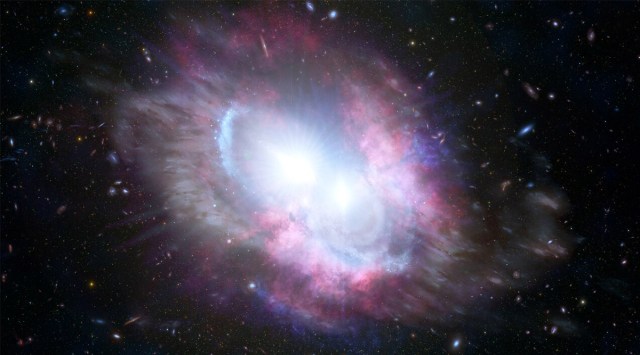Two supermassive black holes spotted lighting up as galaxies collide
This new discovery is the first confirmed detection of a pair of close supermassive black holes during the “cosmic noon,” which was an early period in the universe’s history
 The merger of the two galaxies is feeding the two black holes, making them light up brighter than the galaxies themselves. (International Gemini Observatory/NOIRLab/NSF/AURA/M. Zamani, J. da Silva)
The merger of the two galaxies is feeding the two black holes, making them light up brighter than the galaxies themselves. (International Gemini Observatory/NOIRLab/NSF/AURA/M. Zamani, J. da Silva) Astronomers have discovered two closely bound supermassive black holes as two galaxies merge. This galactic merger actually happened when the universe was three billion years old, but the light is just reaching us now.
Galaxies sometimes merge with other galaxies, putting together their billions of stars to grow and evolve. These mergers trigger bursts of (relatively) rapid star formation. Mergers also fuel the supermassive black holes at their centre, turning them into extremely bright quasars that outshine the rest of the galaxy.
According to US National Science Foundation, this new discovery is the first confirmed detection of a pair of close supermassive black holes during the “cosmic noon,” which was an early period in the universe’s history characterised by bursts of frantic star formation.
Some of these mergers eventually go on to become massive elliptical galaxies containing black holes that are many billion times the mass of our Sun.
Astronomers have observed many different merging galaxies with more than one quasar. But this particular example is special because such instances were rare when the universe was only a quarter of its current age, making them extremely challenging to find, as per NSF.
Looking for such pairs of supermassive black holes that close to each other during that time in the universe’s history is like looking for a polar bear in a snowstorm. The problem is that most such black-hole pairs are too close together to distinguish individually.
For astronomers to be able to definitively detect such a pair, the two supermassive black holes need to be both actively accreting and shining as a quasar at the same time. Both those things are rare by themselves.
According to NSF, statistically, there is only one actively accreting supermassive black hole for every 100 at a given time. And while every quasar is a black hole, very few black holes are quasars. Two accreting black holes that are quasars and also extremely close to each other? The word rare doesn’t cut it.
“The confirmation process wasn’t easy and we needed an array of telescopes covering the spectrum from X-rays to the radio to finally confirm that this system is indeed a pair of quasars, instead of, say, two images of a gravitationally lensed quasar,” said Yue Shen, co-author of the study published in Nature, in a press statement. Shen is an astronomer at the University of Illinois.
According to Yu-Ching Chen, another Illinois astronomer who is also a co-author, knowing about such early black holes will eventually help astronomers understand the emergence of supermassive black holes in the early universe, and how frequent such galactic mergers are.







